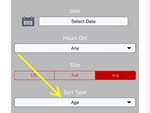When I first started operating on my own authority, I found a great deal of my freight by combing through the freight load boards online and through apps. Being that I had not a single direct customer up my sleeve when I decided to haul for myself and that I was fairly tech-savvy, it seemed like the natural thing for me to do. Here are five things I have learned and put into practice to ensure I am getting the best freight on the boards for my business:
- Know your markets!
 As simple as this sounds, a lot of people don’t realize why certain loads are on the board to begin with. It is far too often that a load will be paying really good because it is going into a freight “dead zone” and you’re ability to get a haul out of that delivery point may have you sitting for days. A key indicator is the “If it’s too good to be true, it probably is” rule when you look at the offered rate.
As simple as this sounds, a lot of people don’t realize why certain loads are on the board to begin with. It is far too often that a load will be paying really good because it is going into a freight “dead zone” and you’re ability to get a haul out of that delivery point may have you sitting for days. A key indicator is the “If it’s too good to be true, it probably is” rule when you look at the offered rate.
- Fresh is better!
 Always filter your search results by “age”, since stale freight that has been sitting on the board for a while is usually sitting there for a reason. If something has been sitting on the board longer than all of the fresh stuff, others generally have passed it up and scraping up the leftovers is generally not a good thing.
Always filter your search results by “age”, since stale freight that has been sitting on the board for a while is usually sitting there for a reason. If something has been sitting on the board longer than all of the fresh stuff, others generally have passed it up and scraping up the leftovers is generally not a good thing.
- Don’t settle for less!
 An offered rate, if the load even has a rate posted, is not the final rate. Unless desperate to cover a particular load, most brokers generally are in the business of making money too! It is more often than not that they will post the load at a haul rate that is the lowest average for that general lane, thus allowing them to maximize profit on whatever the customer has agreed to pay them. Practice your negotiation skills and be prepared to deliver above their expectations for commanding a premium rate. As far as I have always been concerned, all loads are negotiable and I approach them the same way each time.
An offered rate, if the load even has a rate posted, is not the final rate. Unless desperate to cover a particular load, most brokers generally are in the business of making money too! It is more often than not that they will post the load at a haul rate that is the lowest average for that general lane, thus allowing them to maximize profit on whatever the customer has agreed to pay them. Practice your negotiation skills and be prepared to deliver above their expectations for commanding a premium rate. As far as I have always been concerned, all loads are negotiable and I approach them the same way each time.
- Be courteous!
 Niceness goes a lot further than most would think and it begins the moment the broker picks up the phone one the other end of your call. When you call in, this broker may not know you from the next guy, but first impressions go a long way. Be quick, as most brokers have a lot of freight to cover and little time to do it in, but make sure to be respectful in talking to them. If there is a detail about the load you don’t like or the price just isn’t what you need it to be, thank them for their time and ask them to keep you in mind for that lane in the future. It is quite often that I will get a call back within minutes of them hanging up, often after they re-think my professional and courteous manner, offering to come up on price or try and move an appointment time to make the load fit for me to haul.
Niceness goes a lot further than most would think and it begins the moment the broker picks up the phone one the other end of your call. When you call in, this broker may not know you from the next guy, but first impressions go a long way. Be quick, as most brokers have a lot of freight to cover and little time to do it in, but make sure to be respectful in talking to them. If there is a detail about the load you don’t like or the price just isn’t what you need it to be, thank them for their time and ask them to keep you in mind for that lane in the future. It is quite often that I will get a call back within minutes of them hanging up, often after they re-think my professional and courteous manner, offering to come up on price or try and move an appointment time to make the load fit for me to haul.
- Know when to say no!
 Some brokers will try to use pressure tactics and learning to sift these ones out from the bunch is something that comes with time. I liken them to the old-school car dealerships where you would see salesman perched up in the little gazebo above the lot waiting for someone to wander in, allowing them to swoop on in for “the kill”! If a broker dresses a load up to be too good to be true, or is trying to pressure you into a load that just doesn’t fit what you are trying to accomplish for your business, do not be afraid to let them know and decline the load. One tactic they use a lot is leaving out details, or even changing them, when the rate confirmation comes over for you to sign. Scrutinize everything and remember that nothing is final until you sign on the “dotted line”. Don’t be afraid to decline the offer and move on to looking for another load. There are plenty of fish in the sea!
Some brokers will try to use pressure tactics and learning to sift these ones out from the bunch is something that comes with time. I liken them to the old-school car dealerships where you would see salesman perched up in the little gazebo above the lot waiting for someone to wander in, allowing them to swoop on in for “the kill”! If a broker dresses a load up to be too good to be true, or is trying to pressure you into a load that just doesn’t fit what you are trying to accomplish for your business, do not be afraid to let them know and decline the load. One tactic they use a lot is leaving out details, or even changing them, when the rate confirmation comes over for you to sign. Scrutinize everything and remember that nothing is final until you sign on the “dotted line”. Don’t be afraid to decline the offer and move on to looking for another load. There are plenty of fish in the sea!
Getting good freight at good rates is a difficult job at times when combing through the various load boards out there. I do not rely on them as heavily now, since a great deal of my business is repeat and dedicated. A lot of this was due to putting the above practices into play and delivering on promise to the brokers that were willing to pay for premium service in the end. Load boards and brokers posting on them are not all bad, but making sure you weed out those loads and brokers that are not as desirable takes time and patience. Following these five tips can help to make your treacherous journey through the boards just a little bit easier!